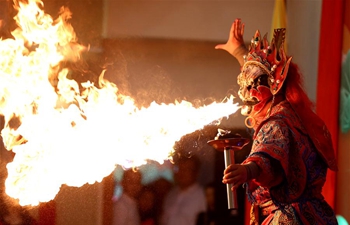WASHINGTON, Feb. 11 (Xinhua) -- Researchers have discovered a special type of untraviolet (UV) light that can kill airborne flu viruses without harming human tissues, according to a new study.
Broad-spectrum ultraviolet C (UVC) light, which has a wavelength of between 200 to 400 nanometers, has been routinely used to kill bacteria and viruses by destroying the molecular bonds that hold their DNA together.
"Unfortunately, conventional germicidal UV light is also a human health hazard and can lead to skin cancer and cataracts, which prevents its use in public spaces," said David J. Brenner, lead author and director of the Center for Radiological Research at Columbia University Irving Medical Center, in a press release published on the university's website.
By contrast, the study found that continuous low doses of far-UVC light, which is around 207 to 222 nanometers in wavelength, is capable to inactivate more than 95 percent of aerosolized H1N1 flu virus in a lab setting.
Moreover, earlier studies have proved that far-UVC light is not harmful to the human body.
"Far-UVC light has a very limited range and cannot penetrate through the outer dead-cell layer of human skin or the tear layer in the eye, so it's not a human health hazard," said Brenner. "But because viruses and bacteria are much smaller than human cells, far-UVC light can reach their DNA and kill them."
If these results are confirmed in other scenarios, the use of overhead far-UVC light in hospitals, doctors' offices, schools, airports, airplanes and other public spaces could provide a powerful check on seasonal flu epidemics and pandemics, said the study.
Flu activity continues to increase across the United States, making the season the most recent "high" severity season, said the U.S. Centers for Disease Control and Prevention in a report on Friday.
At least 63 children have died from flu this winter, it added.

















